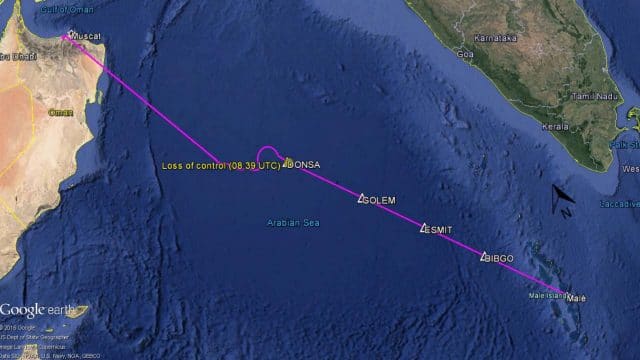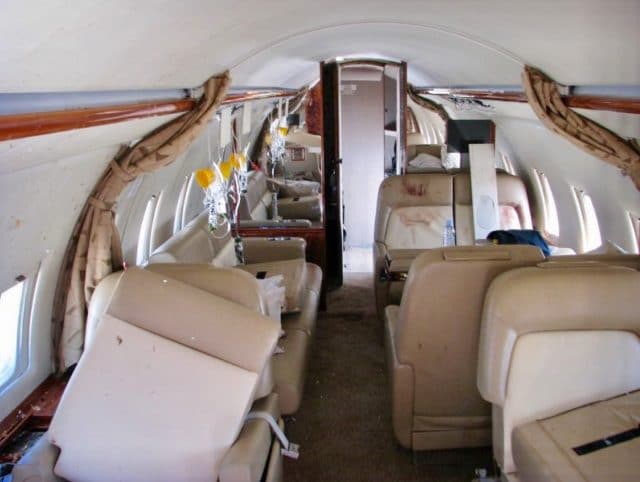BFU Interim Report: Bizjet Flipped by Passing Airbus
The Bundesstelle für Flugunfalluntersuchung (BFU) also known as the German Federal Bureau of Aircraft Accident Investigation, released a preliminary report on the Bombadier CL604 which encountered extreme wake turbulence in January.
I usually wait for the final report but, in this case, it is very straight-forward and I’d be surprised if further details will come to light. The conclusion seems pretty clear although I will revisit that when the final report comes out.
On the 7th of January 2017, two aircraft departed for routine flights: one twin-engine Bombadier CL-600-2B16 (604 variant) business jet and one Airbus A380-861, the world’s largest passenger airliner.
At 06:52UTC, the CL604 departed Malé airport on the Maldive Islands for a flight to Al-Bateen, United Arab Emirates.
At 06:55 UTC, the Airbus A380 took off from Dubai Airport, United Arab Emirates, for a flight to Sydney, Australia.
The flight crew of the CL604 turned the autopilot on as they climbed away to their cruise level at FL340 (34,000 feet). The flight attendent unfastened her seat belt and left the jump seat as they climbed through FL100.
After a short time in the cruise, the aircraft entered the Mumbai FIR where they received clearance to fly to their next reporting point.
Meanwhile, the Airbus was flying a southerly heading at FL350 (35,000 feet).
The aircraft flew towards each other over the Arabian Sea. In the Mumbai FIR between FL290 and FL410, the standard vertical separation is 1,000 feet. The Airbus A380 was at 35,000 feet and the CL604 at 34,000 feet.
It was a clear day of very good conditions. The captain of the CL604, who was the Pilot Flying, had the autopilot engaged. He saw the opposing aircraft on his Traffic Collision Avoidance Service (TCAS) display at a thousand feet above. He looked out and recognised the aircraft as an Airbus A380. He was able to see the Emirates livery and pointed it out to the first officer.

A little less than two hours after take-off, over the Arabian Sea at about 500 nautical miles from land, the Airbus A380 flew over the CL604. The larger aircraft passed slightly to the left and above them flying in the opposite direction.
It was about a minute later when the CL604 shuddered as they hit the wake turbulance.
The CL604 began to roll slightly to the right. Both pilots actuated the aileron in order to stop the aircraft from rolling. The aircraft began to travel faster. The right bank angle increased and one second later, the aircraft was angled 40° to the right. The aileron deflection to the left increased to 20° and the verticle acceleration increased to 1.6 g.
One second later, the vertical accdeleration changed to negative 3.2 g.
To make sense of this, I looked up typical g-forces. At 1.6 g, the force would be slightly more than on the Bugatti Veyron from 0 to 100 km/h in 2.4 seconds.
I couldn’t find anything for -3.2 g, however, other than the general example of negative g-force as a fully inverted roller coaster accelerating towards the ground. Negative g-forces are much more dangerous and the negative g level that aerobatic pilots risk is usually limited to around -2 or -3 g. Blood vessels in your eyes and brain swell up and may burst as your blood pressure increases. After a few seconds, your vision will go red. If the negative g-force is not quickly reduced, blindness can occur. And as with any extreme g-forces, death will follow soon after.
The aircraft accelerated and the pitch angle changed wildly from 3° to 1° to 9° to -20°, all this in just a few seconds. There was a rudder deflection to the left at 11.2° while the bank angle of the aircraft shifted from 42° right to 31° left.
The aircraft continued to roll. The captain’s headset flew off of his head. The Quick Reference Handbook flew around the cockpit, with individual pages coming loose and scattering about. The Inertial Reference Systems, the Flight Management System and the attitude indication (artificial horizon) failed.
The indicated airspeed dropped from 277 knots to 248 knots. The lateral acceleration reached 0.94 g left and the autopilot disengaged.
The aircraft descended rapidly, losing 8,700 feet over 30 seconds. The speed increased to 330 knots. The flight crew, desperately trying to regain control of the aircraft, extended the spoilers and then retracted them again. They reduced the power in the left engine as the Interstage Turbine Temperature increased. Nine seconds later, it had reached 850°. The left engine shut down. The aircraft rolled at least three times and possibly five.

The flight attendant was standing in the middle of the cabin as the Airbus passed overhead. Four of the six passengers were out of their seats. It was obviously a very confused experience but her recollection was that the aircraft had turned three times around its longitudinal axis. She was thrown against the ceiling and the seats, breaking her nose in the process. The four passengers out of their seats were also thrown violently around the cabin. One suffered head injuries and a broken rib, another fractured a vertebra. The armrests of the front four seats fractured and bent. The seats and the panelling were damaged and covered with blood. Oxygen masks fell from their casings.
With the sky and the water both the same shade of blue, the captain said that he was only able to recognise which way was up by finding the clouds.
Finally, the captain regained control and the pilots managed to reactivate the Inertial Reference Systems using a memorised checklist. Thirty minutes after the Airbus 380 had passed over them, they were flying straight and level again. The flight attendent informed the pilots of the situation in the cabin and attempted to reassure the passengers.
The captain contacted Mumbai air traffic control and declared an emergency, reporting their position, altitude and their intention to divert to Oman.
The flight crew restarted the engine and initiated a climb to FL250 (25,000 feet). It was over an hour after the initial upset that they were able to re-engage the autopilot and resume normal flight.
Mumbai ATC contacted Omani ATC to let them know that the CL604 was at FL230 and diverting to Oman, initially explaining that the low altitude was because of an engine failure.
The Airbus A380 continued to Sydney without incident.
At 11:05 the CL604 landed safely at Muscat Airport in Oman.

After landing, four passengers were transported immediately to the hospital in Muscat. Two other passengers and the pilots, all of whom were seated with seatbelts on at the time, were unharmed.
The interim report concludes with what at first glance would seem to be old information. In 2003, a steering group was set up to specify safety requirements, to ensure that the Wake Vortex Encounter risk from the Airbus A380 would be acceptable. They found that during the cruise, the Wake Vortex from the Airbus A380 could descend more than 1,000 feet. The highest risk for a Wake Vortex Encounter – although considered low risk in absolute terms – was for aircraft flying “counter-flow parallel tracks vertically separated by 1000 feet”. They reported that some Wake Vortex Encounter incident reports indicated that moderate to severe Wake Vortex Encounters could be encountered by current operational aircraft.
Such encounters have very low probabilities, but controllers and pilots should be aware that if they occur then the encountering aircraft may experience significant accelerations.
Though this is not an A388 specific issue, and it is beyond the scope of this group, the Work Group strongly recommends review, as a matter of urgency, of spacing for non-Heavy encounters that climb or descend behind all Heavy aircraft generators (including the A388).
It’s uncomfortable to think that fourteen years later, and ten years after the Airbus A380 was introduced into commercial service, this urgent issue was not reviewed. It seems that a dangerous incident had to happen for the risk of heavy wake turbulance to be revisited.
The final report isn’t due until January 2018 but I think it is safe to say that the BFU will be pushing for reconsideration of the minimum separation in light of the wake vortex of modern heavy aircraft like the Airbus A380.
You can read the preliminary report on the BFU website.








Under the circumstances, the crew did very well regaining control and it would seem that the effects of wake control caused by a very heavy aircraft like the A380 has been underestimated more than a bit.
I once encountered wake turbulence from an A380 in a Citation 550. It must have been one of the first in airline service
It crossed our path and we intersected the flight path cause by the 380 more than 10 minutes later. It was quite far, too far to see it. ATC alerted us but considering the distance between us I was not too worried. I cannot remember what the vertical distance had been between our level and that of the Airbus, but it caused a sudden and very sharp jolt.
With more A380s entering service the question of how to counter this must be addressed urgently.
The 380 is significantly larger than a 747, on the other hand this is also a very large airplane, but I cannot recall problems of that magnitude.
I do remember that, in the ‘seventies, a Reims Rocket waiting at the intersection of a runway at Schiphol Airport was flipped upside down by the wake of a 747 taking off and passing the intersection.
The Rocket, nearly new, was a write-off but there were no injuries.
Sylvia mentions a rapid change in g-force from about + 1.6 go to -3.2.
I would not be surprised if this meant seriously in excess of the aircraft’s structural limits; the aircraft may well have had to be scrapped.
I did not know that the 604 is equipped with accelerometers, are they part of the AHRS system? Plus 1.6g is nothing to worry about, it the negative g. Minus 3.6 is in aerobatic territory for which the 604 is neither approved nor built. You cannot really draw a comparison with a car because the forces are working in totally different ways and directions. Also, the rapid change from positive to substantial negative g would have subjected the aircraft to more abuse for which it has not been designed.
You are right about the structural limits.
“The aircraft manufacturer determined that the airframe structure could not be restored to an airworthy state as it exceeded the airframe certification design load limits during the upset encounter. Therefore the aircraft is considered to be damaged substantially.”
Perhaps volumes of air displacement need to become considered with all new large body aircraft. I don’t know how old the 1000ft rule is but I wouldn’t be surprised that it comes from propeller aircraft!
Sylvia confirms what I thought. The aircraft involved in the upset has been exposed to loads that were outside the design limits and is probably beyond economical repair.
Jim, the considerations about separations were drawn up to protect aircraft flying under IMC (instrument meteorological conditions) against mid-air collisions. At first, there was the so-called “Quadrantal Rule”, a bit cumbersome and complicated. Later it was replaced by the semi-circular rule. The quadrantal rule was not scrapped altogether, it lived on in the UK to separate VFR and IFR traffic operating outside controlled airspace but I think that by now this also may be part of aviation history.
The minimum vertical separation was 1000 feet between aircraft flying in opposite direction, but due to the thinner air it was raised to 2000 feet above FL 290. So, FL 290, next 330, 370, etc. and opposite track 280, 310, 350, 390.
As a result of more accurate, electronic ways of measuring height and increasing demands on airspace, later “RVSM” was introduced: (Reduced Vertical Separation Minima), whereby properly equipped and certified aircraft, operated by RVSM licensed crew were only allowed to operate in the higher airspace and vertical separation became 1000 feet also above FL 290.
RVSM ended at FL 420 and non-RVSM certified flights, if able to quickly climb trough RVSM airspace, could be cleared for FL 430 or higher.
This all has nothing to do with wake turbulence created by (very) heavy aircraft and the aviation authorities of all (ICAO) countries will have to get together and work this out before another serious incident happens.
Wake turbulence is not so much the result of the “displacement of a large volume of air”. It is the result of creating lift: denser air at the underside of a wing will try and “fill the gap” of less dense air on the upper side. Due to the forward speed of the aircraft, this happens at the wing tips. Air flows from under the wing and arrives at the top as a rotating stream which continues to be left behind as long as the aircraft is in the air.
It is related to the required lift, generated by the wing, rather than the amount of air pushed aside by the fuselage.
This rotating stream of air can sometimes be seen if the air is very humid: the vortex cannot contain all the water vapour and condensates, the same can often be seen at the top of the wing especially at low speeds. If the landing flaps are extended and the air is damp, interference can cause the same: “ribbons” of water vapour will be generated by the difference between the flaps and the other parts of the wing. So if you see that, it is totally normal.
The wingtip vortex generated by a very heavy aircraft can have a lot of energy – as the article by Sylvia demonstrates: enough to violently flip a serious bizjet upside down and cause severe damage. It is also known to drift down behind and below the flight path of the aircraft that generated it.
It has perhaps come to a surprise of the experts that it still has very much of that energy 1000 feet ( 300m.) below the track of the A 380.
Wing tip vortex part 2.
(since I started this, I should finish it !).
An aircraft needs lift, that is obvious. That lift is generated by the wings (assuming a conventional fixed-wing aircraft of course) and the wings move through the air, generating this lift.
Unfortunately, the process creates drag which increases with the square of the speed through the air. In flying school we learned that D=1/2 rho V square. D=drag, rho (the Greek “R”) stands for air density and V, well we all know that represents airspeed.
So far so good.
In order to fly straight and level, lift must equal weight. An A380 is very heavy so we need a lot of lift.
Drag is caused by the frontal area of the aircraft pushing through the air but also generating lift itself causes drag.
And this process is the cause of the wingtip vortices that can, if generated by a large aircraft, be rotating at such a force that it can knock a business jet out of the sky. Read Sylvia’s article!
The vortex also causes a lot of drag. Until maybe 30 years ago, it* was considered an unavoidable byproduct of the way a wing creates lift (*induced drag).
In the ’70s Learjet engineers came up with a solution: they created the Lear 29 “Longhorn”. This had rather high and very prominent winglets, similar to the kind we now are so familiar with.
It was not a dramatic sales success. The wings had to be beefed up in order to take care of the extra load generated. The 29 was a straight jet, not exactly renowned for its fuel efficiently. A colleague of mine, who flew a 20-series Lear, when belittled by another pilot who had joined Aer Lingus to be flying the Boeing 737-200, responded: “I can outclimb you, I can outmanoeuvre you, I can make more noise than you and I can burn more fuel, too”. Millionaires who could afford a Lear would not be overly worried about the fuel consumption.
But the “longhorns” worked. By obstructing the flow and so reducing the amount of air that moved from the underside of the wing to the top, winglets as they are now generally known, substantially reduce induced drag, in effect enhancing the energy that the engine thrust represents.
Since they reduce drag, they also reduce fuel burn, increase the speed, the range of the aircraft and in the process also reduce the energy imparted by the wingtip vortices.
Wingtip devices, most of them, are “winglets”. Apart from the other benefits, they also can add stability, even by clever aerodynamics, create extra lift.
Airbus, for the A319/320/321 family opted for triangular “fences”. They are supposed to accomplish the same as winglets but for the A330/340 and 350 family winglets were chosen.
The A380 again has a version of the triangular fences.
Funnily, Airbus offers an optional winglet for the A320 series, which can be retrofitted, called “sharklets”. The improvement in fuel efficiency is claimed to be 4% or better, which is significant. It raises the question why the fences were chosen for the 380 in the first place. If a “sharklet” conversion were adapted, it could increase efficiency by another 3.5 – 7 % with, presumably, a corresponding decrease in the energy of the vortex. It would be a “win-win” situation: increased fuel efficiency, increased range, increased speed and decreased induced drag, meaning a less powerful vortex.
An A380 still needs an awful amount of lift and so will unavoidably create a lot of induced drag (with resulting vortex), but the difference may be “only” a scare instead of a near-calamity.